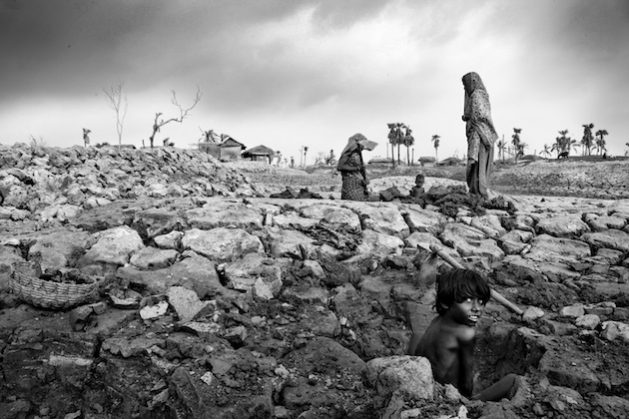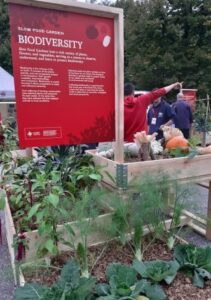
Africa, Biodiversity, Conferences, COP16, Development & Aid, Economy & Trade, Editors’ Choice, Featured, Food and Agriculture, Food Security and Nutrition, Food Sustainability, Headlines, Natural Resources, Sustainable Development Goals, TerraViva United Nations

The International Livestock Research Institute is using genomics to breed livestock suited to local conditions and production systems to meet community needs. Credit: Busani Bafana/IPS
– Christian Tiambo has always wished to uplift local farmers’ communities through cutting-edge science.
As climate change wreaked havoc on local agriculture, Tiambo, a livestock scientist at the Centre for Tropical Livestock Genetics and Health (CTLGH) and at the International Livestock Research Institute (ILRI), focused on conserving and developing livestock that could withstand environmental stress.
Genomics, a Game Changer
Tiambo’s research took an exciting turn when part of his PhD studies was to characterize and establish local poultry populations with interesting resilience potential. Yet, the need for local access to advanced genomic tools was a barrier to fully unlocking this potential.
Today, the power of digital data and sequencing information is transformative. It is driving the discovery of genes and innovation in agriculture through the identification and deep characterization of pathogens in plants and animals. That is helping scientists to breed livestock suited to local conditions and production systems, thereby benefiting local communities that have been custodians of genetic resources for generations.
But there is a catch: Africa, like other parts of the global south, is a genetic goldmine but has not fully capitalized on the digital sequencing information (DSI) derived from its genetic heritage. DSI is a tool that provides information for the precise identification of living organisms and allows the development of diagnosis tools and technologies for conservation in animals and plants. Besides, DSI is also used in investigating the relationships within and between species and in plant and animal breeding to predict their breeding value and potential contribution to their future generations.
Tiambo said DSI can be used to adjust the genotypes and produce animals with desired traits, adapted to local conditions but which have higher productivity.
A promising innovation has been the development of surrogate technologies in poultry, small ruminants, cattle or pigs—giving opportunity to local and locally adapted and resilient breeds to carry and disseminate semen from improved breeds in challenging environments.
“Farmers would not need to keep requesting inseminators and semen from outside their village,” Tiambo explained, noting that this shift could dramatically improve livestock breeding, dissemination of elite genetics, boost food security and alleviate poverty in remote rural areas of Africa.
Global cooperation among stakeholders of the Kunming-Montreal Global Biodiversity Framework is key to establishing international guidelines on benefit-sharing from animal genetics resources and their associated information, including DSI.

Christian Tiambo, a livestock scientist at the Centre for Tropical Livestock Genetics and Health. Credit: ILRI
Using genetics and associated traditional knowledge includes adapting specific livestock to specific environments. This contributes to the development of improved and elite tropical animal breeds with particular traits that meet community needs to improve livelihoods, he said.
“Local livestock is not just for food but is our heritage, culture and social value,” said Tiambo, adding that conserving livestock is conserving local culture, social ethics and inclusion, with gender aspects being considered. For example, the Muturu cattle and the Bakosi cattle in Nigeria and Cameroon are animals used in dowry, The Bamileke cattle remain sacred and maintain the ecosystem of sacred forest in part of the western highlands of Cameroon.
“I have never seen any traditional ceremony done with exotic chicken in any African village,” he said.
Genetics and DSI, according to Tiambo, are “game changers” in breeding livestock with desired traits faster. What used to take five to seven years or more, he says, can now be done in just three or four cycles with the help of genomics.
ILRI has been working with the Roslin Institute, the Kenyan Agricultural and Livestock Research Organization and collaborating with the African Union-InterAfrican Bureau for Animal Resources (AU-IBAR), the National Biosafety Authority, farmer communities, and National Agricultural Research Systems (NARS) in Africa and Southeast Asia in the conservation and development of improved local chicken using stem cell technologies.
Bridging the Capacity Gap
DSI needs infrastructure and human resources. “A lot of infrastructure, equipment and skills are coming from outside Africa, but how can we also generate DSI and use it locally?” Tiambo asked. He worries that without developing local capacity to harness DSI, “a lot of helicopter research will still be happening in Africa where people fly in, just pick what they want, fly out, and no scientists in Africa are involved in generating and using DSI.”
Technologically advanced countries have often exploited these genetic resources, developing commercial products and services without clear mechanisms for sharing the monetary and non-monetary benefits with local communities as ethics and common sense would require—an injustice that needs urgent correction.
The use of DSI on genetic resources is one of the four goals of the Kunming-Montreal Global Biodiversity Framework adopted in 2022 with the aim of stopping global biodiversity loss by 2030.
ThankGod Ebenezer, bioinformatician and co-founder of the African BioGenome Project, argues that Africa must seize this moment to build and strengthen local capacity to produce and use DSI from genetic resources.
“The establishment of a benefit-sharing mechanism for DSI is a first step in the right direction and Africa needs to maximise even this first step by putting in a framework to generate and make use of DSI locally,” Ebenezer told IPS, explaining that Africa needs to be able to do genetic sequencing on the ground with local scientists having the capacity to translate and use it.
The Africa BioGenome Project, of which Tiambo is also a founding member, is a continental biodiversity conservation initiative that has laid out a roadmap for how Africa can benefit from DSI and the planned multilateral fund.
“The main benefit comes from being able to use DSI and ultimately share it with the global community in line with the national and international rules and regulations,” said Ebenezer. “Because if you cannot use DSI yourself, you will always feel like a supplier, like someone who gets crude oil from the ground and asks someone else to add value to it and gets several products.”
“The multilateral fund is key,” Ebenezer stresses. “If someone converts DSI into revenue, for instance, they’re only looking at paying 1% back into the fund. Is that enough for the communities that hold this biodiversity?”
At COP16 in Colombia (Oct 21-Nov 1, 2024), world leaders will discuss mechanisms for fair and equitable sharing of DSI benefits, a critical step for Africa and other biodiversity-rich regions. For example, Africa hosts eight of the 34 biodiversity hotspots in the world, according to the Intergovernmental Platform on Biodiversity and Ecosystem Services (IPBES).
“In terms of the negotiation, we would like the DSI fund to be approved so that it’s ready for implementation because this is an implementation COP,” Susana Muhamad, Minister of Environment and Sustainable Development of Colombia and COP16 President-designate, told a press briefing ahead of COP16.
“We would like the decision of the parties to give the COP the teeth for implementation. One is the DSI,” Muhamad said.
Astrid Schomaker, Executive Secretary of the UN Convention on Biological Diversity, is hopeful that COP16 will operationalize the multilateral mechanism for the sharing of benefits from the use of digital sequencing information in genetic research.
“We are going to look at that. And I think it’s a very complex term and issue, but it is ultimately about how those industries, sectors and companies that use digital sequence information on genetic resources that are often located in the global south, but not exclusively, how they use it and how they pay for using it,” said Schomaker, noting that COP15 agreed to establish a multilateral mechanism and a Fund for DSI.
The fair and equitable sharing of benefits arising out of the use of genetic resources is one of the three objectives of the CDB, including the conservation of biological diversity and sustainable use of its components. Target 18 of the CBD seeks to reduce harmful incentives by at least USD 500 billion per year by 2030, money that could be channelled to halting biodiversity loss.
The World Resources Institute (WRI), in a position paper, has urged COP16 to provide more finance and incentives to support nature and biodiversity goals.
There is currently a USD 700 billion gap between annual funding for nature and what’s needed by 2030 to protect and restore ecosystems, the WRI said, noting that “many of the world’s most biodiverse ecosystems—and biggest carbon sinks—are in developing countries that cannot save them without far more financial support.”
The WRI commented that bringing in more private sector finance will require incentives, which can come from policy and regulation as well as market-based strategies to make investments in nature more attractive.
But this should not substitute for shifting harmful subsidies and delivering international public finance to the countries that need it most, WRI argued.
As the world scrambles to stop biodiversity loss by 2030, the upcoming COP16 discussions could be pivotal in ensuring that Africa finally benefits from its own genetic wealth.
IPS UN Bureau Report


















